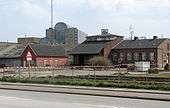Aarhus Godsbanegård

Aarhus Godsbanegård (Aarhus Goods Station) or simply Godsbanen is a cultural centre in Aarhus, Denmark since 2012. It is a former goods station in use from 1923 to 2000, located at the end of a broad sidetrack to the central railway yard of Aarhus. In December 2010, Realdania announced that the area would be gradually transformed into a modern city district, through a collaborative project with Aarhus Municipality. Apart from the new cultural centre of Godsbanen, there are plans to build several buildings and institutions along the former railway yard, including a new school of architecture.[1][2]
History


Originally the goods station of Aarhus was situated at Aarhus Central Station, on the site now occupied by the Aarhus Bus Station.
In the 1890s, it was proposed to move the goods yard to Mølleengen from its original location. The plans for the move became part of the city planning in 1896 and 1898 but a full 27 years went by before they were executed. As the project was very costly, it led to extended discussions in both the city council and the national parliament, the latter being reluctant to provide funding.
Only after a law was passed in 1917 covering relocation of the shunting yard and the goods station to Mølleengen near the Aarhus River were the plans put into practice. In 1919, a new city plan was adopted and in 1920 work on the new goods station in Skovgaardsgade was able to start. Owing to difficult soil conditions, extensive piling work had to be carried out, including 1,150,000 m3 of landfill which was moved by hand. In addition, a portion of the river was moved further north, and 3,000 fir trunks were pounded in to a depth of 20 meters as foundations for the facility's new buildings. The engineer responsible for the foundation work was track manager Thorvald Engqvist.
The goods station's main building was designed in a Neo-Baroque style by architect Heinrich Wenck and built in 1920-22 after a design phase that had begun in 1918. It was one of Wenck's last works as DSB's chief architect. The two-storey building is 15 bays long and is crowned by a hipped roof with a lantern and four ridge turrets together with a copper-clad spire topped by a Baroque onion dome. The facade is divided into lesenes. It is built of red brick and roofed with red tiles. The ventilation hoods and the flashing around the dormers are also in copper.
Perpendicular to the main building are two warehouses, originally on either side of a yard where the tracks came to a blind end. This was where the loading and unloading of the incoming and outgoing freight trains took place. In 1972 and 1984, the yard between the warehouses was transformed into a building connecting the warehouses. In 1925, the shunting yard was inaugurated together with the goods station.
Most buildings in the area have high preservation status in the Aarhus municipal atlas.
The cultural centre
In recent years the main building has been restored, the two warehouses has been rebuilt and refurnished and a new building has been erected in between, to house a new cultural centre named Godsbanen. Godsbanen opened on 30 March 2012[3] and organize a host of cultural arrangements and facilitates everyday cultural engagement for the citizens of Aarhus and surrounding suburbs. This includes theatre, dancing, music, film, artwork, printing, workshops, festivals and business networking.[4] Since the opening of the centre, there has been a restaurant and café, at the center of the new building, but it has changed owners and concept several times. The former restaurant of Thorvalds (named after the goods station's first manager Thorvald Engqvist) took over from Aarhus Folkekøkken (Aarhus Civic Kitchen) and is now replaced by Spiselauget. With slightly varying concepts, the restaurants has always focussed on sustainability and organic, seasonal and local produce.[5][6][7][8]
-

Restaurant and café area at Godsbanen.
-
.jpg)
Radar, a small music venue at Godsbanen.
-

From the walls of Godsbanen. The Danish text loosely describes the concept of the cultural centre.
-
The tilted rooftop of the new Godsbanen cultural centre
-
.jpg)
Institute for (X), a selfgoverning DIY town for creative startups.
References
- ↑ "Byggeriet af en ny arkitektskole i Aarhus kan nu skydes i gang [The construction of a new school of architecture in Aarhus can now begin]" (in Danish). Aarhus School of Architecture. 26 August 2015. Retrieved 11 October 2016.
- ↑ "Ny arkitektskole i Aarhus [New school of Architecture in Aarhus]" (in Danish). Danish Association of Architects. 19 April 2016. Retrieved 11 October 2016.
- ↑ From godsbanegård to Godsbanen Archived February 22, 2014, at the Wayback Machine. NRGi (Danish)
- ↑ About Godsbanen Godsbanen
- ↑ "About Spiselauget". Spiselauget - Godsbanen (in Danish). Retrieved 17 October 2014.
- ↑ Tobias Heede Niebuhr and Hans Petersen (18 January 2014). "Financial mess sends the Civic Kitchen of Godsbanen bankrupt". Århus stifstidende (in Danish). Retrieved 17 October 2014.
- ↑ Hans Petersen (21 March 2014). "Now the food workshop at Godsbanen is on track". Århus stifstidende (in Danish). Retrieved 17 October 2014.
- ↑ Kirstine Lefevre Sckerl (8 August 2014). "The restaurant at Godsbanen has become Spiselauget". Århus stifstidende (in Danish). Retrieved 17 October 2014.
Sources
- Søren Bitsch Christensen (ed.): Århus Godsbanegård - historie og kulturarvsanbefalinger. January 2009, Dansk Center for Byhistorie 2009. (Danish)
External links
| Wikimedia Commons has media related to Godsbanen. |
- Godsbanen (Danish) English available
Coordinates: 56°09′15″N 10°11′41″E / 56.15417°N 10.19472°E